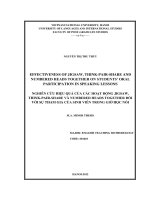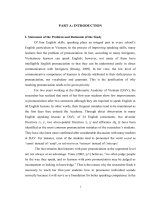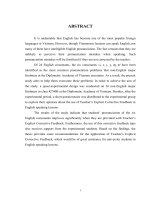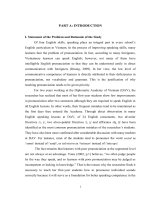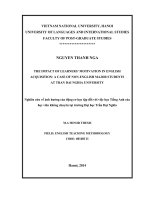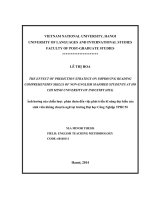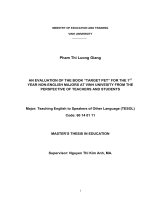Evaluating the effectiveness of using think pair share strategy in improving the participation and confidence of non English majors in speaking lessons at Hai Phong University (HPU)
Bạn đang xem bản rút gọn của tài liệu. Xem và tải ngay bản đầy đủ của tài liệu tại đây (5.76 MB, 8 trang )
EVALUATING THE EFFECTIVENESS OF USING THINK-PAIR-SHARE
STRATEGY IN IMPROVING THE PARTICIPATION
AND CONFIDENCE OF NON-ENGLISH MAJORS IN SPEAKING LESSONS
AT HAI PHONG UNIVERSITY (HPU).
Phan Thị Hường
Khoa Ngoại ngữ
Email:
Ngày nhận bài: 07/5/2020
Ngày PB đánh giá: 09/6/2020
Ngày duyệt đăng: 19/6/2020
ABSTRACT: Think-Pair-Share strategy (TPS) is considered an effective strategy to help students
improve their language skills. Therefore, the study was conducted to evaluate at evaluating its
effectiveness in enhancing students’ participation and confidence for non-English majors at the faculty
of Tourism in speaking lessons. The research design used a mixed method to collect data from 24
students in the faculty of Tourism at HPU. The results of the research showed that TPS strategy brought
to considerably effective improvements to students’ participation and confidence in speaking lessons.
Keywords: Think-Pair-Share strategy; Speaking skill; Non-English majors
ĐÁNH GIÁ TÍNH HIỆU QUẢ CỦA VIỆC SỬ DỤNG CHIẾN LƯỢC CHIA SẺ - NHÓM - ĐÔI
TRONG VIỆC CẢI THIỆN SỰ THAM GIA VÀ SỰ TỰ TIN CỦA SINH VIÊN
KHÔNG CHUYÊN ANH TRONG CÁC GIỜ HỌC NÓI
TẠI TRƯỜNG ĐẠI HỌC HẢI PHÒNG (HPU).
TÓM TẮT: Chiến lược Chia sẻ - Nhóm - Đôi (TPS) được coi là một chiến lược hiệu quả giúp cải thiện
các kĩ năng ngôn ngữ của sinh viên. Vì vậy, nghiên cứu này được thực hiện nhằm mục đích kiểm tra
tính hiệu quả của nó trong việc cải thiện sự tự tin và sự tham gia của sinh viên không chuyên khoa Du
lịch trong các giờ học nói. Nghiên cứu sử dụng phương pháp nghiên cứu hỗn hợp để thu thập dữ liệu
từ 24 sinh viên khoa Du lịch, trường Đại học Hải Phòng. Kết quả của nghiên cứu chỉ ra rằng phương
pháp Chia sẻ - Nhóm - Đôi mang tới nhiều thay đổi tích cực với sự tham gia và sự tự tin của sinh viên
trong các giờ học nói.
Từ khóa: Phương pháp Suy nghĩ - Nhóm đôi - Chia sẻ; Kĩ năng nói; Sinh viên không chuyên Anh
1. INTRODUCTION
Relating to the comprehensive
development of language skills, speaking
skill is one of the most challenging factors
for students. Because this skill requires the
combination of a lot of knowledge such as
vocabulary, grammar, pronunciation and
114 TRƯỜNG ĐẠI HỌC HẢI PHÒNG
sentence structure to confidently present the
opinion in front of others. The researcher
also realizes that the development of oral
communication in and out of the language
classrooms plays a significant role in
learning process, however, students
normally have few chances to practice
speaking or communicating with others
by the target language. In most cases,
they feel timid, embarrassed or frightened
when being required to express their idea
or communicate with others in English.
Consequently, most of students show the
reluctance to their study, refuse to take
part in activities with others or even feel
stressed in each lessons. Non-English
majors in the faculty of Tourism are also
not an exception, they are compulsory
to complete two ESP subjects with the
professional knowledge which focus on
developing the speaking skill to cater for
their future jobs. However, most of the
student are not confident in communication
as well as do not have chances to practice
English speaking in reality and in learning
process. The reasons may be the limitation
of basic English knowledge, the lack of
self-confidence, the embarrassment or
shyness if accidentally making mistakes
when speaking in front of others.
Therefore, teachers always try their best
to find out the suitable methods to help
students improve their learning.
in improving vocabulary mastery of the
second class students of Muhammadiyah
vocational high school. The author
showed that TPS strategy could help
students improve their vocabulary
mastery, make make the students more
interested and actively involved in the
learning process. In addition, the research
of Andrew P. Kwok1, Alexandria Lau
(2015) about the using TPS in promoting
cooperative learning strategy, the study
also pointed out that “TPS enhance the
cognitive learning process. The students
had more academic learning time spent
in discussion, enhanced their thinking
process from peer’s corrective feedback
and self-reflection for deeper and more
thorough understanding”.
Think-Pair-Share strategy proposed by
Lyman (1981) is considered an effective
and efficient one for most of the students
to bring positive changes in learning
process as well as increase students’
learning motivation. In particular, there
are some studies about the effectiveness
of using Think-Pair-Share strategy
investigated by researchers. For example,
the research of Abdurrahman Hi Usman
(2015) studied about using TPS strategy to
improve students’ speaking ability at Stain
Ternate. The researcher said that students
achieved the positive result in speaking
lessons and the good improvement in
their ability. Another study of Ida Ubaidah
Hidayati (2012) about the effect of TPS
1. What is the effect of TPS strategy to non-English majors’ confidence in
speaking lessons at HPU?
Therefore, to help my students
increase the confidence and participation
in speaking lessons, the teacher decided
to apply TPS strategy in learning process
to evaluate its real effectiveness to nonEnglish students in the faculty of Tourism
at HPU. Two following questions are used
to clarify the main target of the research:
2. What is the effect of TPS strategy
to non-English majors’ participation in
speaking lessons at HPU?
2. DEVELOPMENT
2.1 Literature review
2.1.1 Speaking skill
Speaking skill is believed to be one
of the most challenging and important
part in learning foreign language
process, especially for foreign language
students because this skill requires them
TẠP CHÍ KHOA HỌC, Số 41, tháng 7 năm 2020
115
to develop oral communication ability
comprehensively. According to Brown
(2004) “speaking is a productive skill that
can be directly and empirically observed,
those observations are invariably colored
by the accuracy and effectiveness of
the test-takers listening skill, which
necessarily compromises the reliability
and validity of an oral production test”.
Thornbury (2005) also said that speaking
was an interactive process and required
the ability to cooperate in the management
of speaking turn. In general, speaking is
an interactive cooperation developed
and enhanced as means of effective
communication
through
producing,
receiving and processing information.
Speaking skill is also a complicated
process with the simultaneous participation
of both speakers and listeners. Therefore,
students are forced to accumulate their
knowledge then apply to express their ideas
as well as numerous language functions
not only inside but outside classroom.
However, “communication can only be
effective when the student is sensitive to
the social and cultural aspects of language
use and how these differ between his first
and second language” (Applegate,1975).
Therefore, to improve the effectiveness
in speaking lessons, teachers need pay
attention to using suitable teaching
approaches, provide students with
interesting activities as well as create more
learning motivations for them.
For most non-English majors in HPU,
speaking is really a challenging task because
they need to deal with language obstacles
which prevent them from expressing their
opinion fluently and confidently. Besides,
their psychology of shyness, unfamiliarity
to present in front of others as well as lack
116 TRƯỜNG ĐẠI HỌC HẢI PHÒNG
of chance to practice speaking English
causes them not to gain a good speaking
skill. Therefore, there are a lot of different
techniques used to help students develop
their communicative skills through
interactive strategies, TPS strategy is one
of the most popular strategy to be used to
improve students’ speaking skill.
2.1.2 Think-Pair-Share strategy
Think-Pair-Share strategy is a
cooperative learning technique which is
proposed by Lyman (1981) and proved
by a lot of researchers to bring a lot of
benefits such as (Lujan & DiCarlo, 2006);
(Goodwin, 2005); (Arends, 2008). Using
cooperative learning strategy means that
students in different levels of ability
use a wide variety of learning activities
such as work in pair, in a small group
or in a combination of both to improve
their academic achievement, skills and
students’ self-esteem (Goodwin, 1999).
Each student participates in activities not
only for learning but also for helping other
teammates by giving immediate feedbacks
and reinforcements. The common goals
of applying TPS strategy are to increase
students’ participation in speaking, enhance
students’ confidence in speaking lessons.
As a result, they can partly improve their
academic achievement, develop language
skills and the ability to work with others.
A lot of teachers select TPS to apply in
their classroom because this cooperative
learning strategy is considered as an
effective way to diversify class discussion
atmosphere (Trianto, 2007). Lyman
(1981) gives three steps in the TPS
procedure including students are given a
task or assignment to think individually
in a short period of time, they think about
the answers of the question, formulate
and organize them in a suitable sequence.
Then students work in pair or in a group
to discuss their thinking with teammates
and report their findings for relating
tasks. This was considered an advantage
of this strategy because Pressley (1992)
said that the activity allowed students to
have opportunity to think and provided
them with a good chance to find out
what knowledge they knew and what
knowledge they needed to study more. In
the final step, students share their opinion
with other individuals in the group which
creates the chances to interact with the
whole group, present their own idea in an
active manner as well as stimulate the oral
communication skills.
Besides, TPS strategy is a favorite
activity of a lot of researchers because
the evidences for the positive effect
on studying process are given. Firstly,
according to Lie (2002), “Think-PairShare is learning strategy that gives
students the opportunity to work
independently and in collaboration
with others”, which helps build the
peer interaction and the positive
interdependence because the success
of the whole group depends on the
individuals’ participation, so every group
member’s participation and engagement
is essential (Johnson & Johnson, 1999).
Moreover, TPS learning strategy also
helps develop students’ self-studying
thanks to putting students in the center
of learning activities, turning teachers’
role into guidance and organization.
Therefore, active engagement of
students is stimulated, more students
participate in the classroom’s activities
to debate, communicate with other
students which creates an ebullient and
effective learning atmosphere.
Secondly, according to (Johnson &
Johnson, 1999) face-to-face interaction
is also an advantage of TPS strategy.
Because it engages the whole class, allows
all students including low-level students
or timid students to take part in and reflect
their idea. TPS strategy also reduces
putting too much pressure on individuals
when responding to the questions in front
of the class which motivates students’
confidence and participation. Besides,
allowing students to have enough time
to think about the questions or tasks then
discuss with others is also an advantage
making students feel more confident in
answering rather than responding directly
by themselves. As Westwood, Peter and
Oliver (1979) mentioned that teachers
needed ensure active participation because
what student practiced saying would help
improve communicating ability not what
they heard.
Besides, the competition among
groups or pairs also helps students have
more confidence in learning, thinking and
expressing their own ability. This learning
strategy also requires students to learn
the way to work with other in the team,
learn how to express their opinions, share
and respect other’s opinion basing on the
common goals or objectives. As the result,
students can gradually improve critical
thinking, problem solving, decisionmaking skills and feel more interested in
the enjoyable learning environment.
In general, using TPS learning
strategy has been proved to bring students
more benefits. Therefore, the researcher
decided to doing a study to evaluate the
effectiveness of using TPS strategy in
improving students’ participation and
confidence in speaking lessons.
TẠP CHÍ KHOA HỌC, Số 41, tháng 7 năm 2020
117
2.2 Methodology
The study uses a mixed method
including questionnaire surveys and
observation method to collect data for the
study. Because questionnaire surveys are
very effective and useful for the research
as Richards and Lockhart (1994) said
that questionnaires were a useful way of
“gathering information about effective
dimensions of teaching and learning,
such as beliefs, attitudes, motivation, and
preferences, and enable a teacher to collect
a large amount of information relatively
quickly.” Therefore, in this study, they
can help me investigate students’ actual
learning situations in speaking lessons.
Secondly, to observe non-verbal gestures,
facial expressions as well as the change
in student’ attitude and participation in
learning process, the author decides to
use the observation method which is
considered as a useful technique of carrying
out research in psychology. Its goal is to
obtain a snapshot of specific characteristics
of students which are normally difficult
to collect through questionnaire surveys.
Therefore, using observation method helps
the author discover the level of confidence
and participation of students in learning
process.
2.2.1 Research setting and participants
This study was conducted in eight
weeks from November to December,
2019 in the faculty of Tourism at Hai
Phong University. The subject is English
for Hotel industry which is an English for
specific purpose subject (ESP) has the aim
to provide students basic knowledge of
hotel industry and develop the ability to
communicate with foreign customers in
some common situations. Students apply
the ESP knowledge to communicate in
118 TRƯỜNG ĐẠI HỌC HẢI PHÒNG
different situations, thus speaking is a
compulsory content in learning process.
There were eleven units used for this
program, the participants are twenty-four
juniors of Tourism administration class
including both 16 female students and 8
male ones with the pre-intermediate level.
2.2.2 Data collection instrument and
research design
This study had the main aim to evaluate
the effectiveness of using TPS strategy
in improving student’s confidence and
participation in speaking skill, therefore
a mixed method research design was
given. Using the data in different manners
can help the researcher to get a thorough
picture of students’ view of their abilities,
their attitude to speaking skill, their actual
participation in class discussion and the
ways they took part in speaking lessons.
Students were announced about the
purpose of the study at the first lesson and
all agreed to participate. In the first week
and the final week, the author carried out
collecting data through pre-survey and
post-survey test about students’ attitude to
speaking skill. In the following five weeks,
the author implemented observation
method to get data for the research.
The procedure of the study included the
following steps, firstly teachers prepared
materials for teaching strategy including
observation checklists, field notes, criteria
for assessments. During the study, in
each lesson, students were given a small
task to discuss some given questions in
a group of four while teacher observed
the way students applied TPS strategy.
After a limited period of time, teacher
accidentally asked one students in a certain
group to present their idea of the group
and marked. One another activity using
TPS strategy was that students worked
in pair to make a short conversation with
the given topic, after that, teacher invited
some of them to present. To collect data,
the researcher used an observation list
to assess the process of applying TPS
strategy included the information of
such as participants, frequency and their
attitude. Students were marked in different
columns with a tick to show the evidence
that they were active in conversation by
posing questions, gave a long explanation,
responded quickly to the answer, gave
feedbacks to partners or showed what
their attitude in speaking lessons. Finally,
the researcher summarized all collected
data to analyze and gave the findings for
the study.
2.3. Findings of the research
With the purpose to answer the
questions for the study about the changes
of students’ participation and confidence
in speaking lessons, the collected data
showed a significant improvement in
students with Think-Pair-Share strategy.
To clarify the result of changing students’
participation and confidence in learning
speaking, the researcher carried out
analyzing the result of the pre-survey
and post- survey. There were six given
questions, the following table illustrated
the answers for the study.
Besides, two open questions were
also given to find out the result of using
TPS strategy in the post survey. For the
first question “Do you feel interested in
taking part in speaking skill? Why”, most
of students agreed with the advantages of
using TPS as some suggested answers.
Firstly, teachers allowed them enough time
to discuss, thanks to the period of time they
could communicate with their friends to
understand more about the assigned tasks,
had a chance to discover new knowledge
and found out the best solution. Secondly,
accidentally appointing students to present
idea by teacher forced all students in the
group to take part in and master knowledge
which avoided the concentration of task in
one individual. Moreover, the atmosphere
in speaking lessons seemed to be more
comfortable and competitive with various
chances to practice speaking directly with
their partners.
For the second question “Do you
think that your speaking skill is partly
improved thanks to TPS strategy?” Nearly
all agreed with the idea and there were
some suggestions chosen by students
including I felt more confident to speak,
I could speak longer sentences, I knew
how to structure the content of speaking
and I could apply more specific purpose
knowledge in communicating better.
At the same time, the data which was
collected through observation method
helped the researcher understand more
about students’ participation. For the first
week, some students did not show active
attitude in speaking skill (Tien Anh, Ngoc
Hai, Duc Hai, Hai Giang, Hong Chung,
Hoa, Hieu, Lien, Mai, Thu, Trang). They
showed the shyness, embarrassment in
communication. They also used more
Vietnamese in discussion, answered in
short sentences and made a lot of mistakes
in grammar and pronunciation. Even Ngoc
Hai, Chung and Tien Anh only spoke one
or two sentences in Vietnamese and sat
silently. In the class, only Huong, Thuy,
Ngoc Linh and Hong were active in their
activity, gave long answers, explained the
answers with the peer while other students
also tried to take part in but most of them
TẠP CHÍ KHOA HỌC, Số 41, tháng 7 năm 2020
119
showed the nervousness and troubles
in speaking process. Even some groups
could not complete the assigned tasks in
the required time.
In the second and third week, students
had more willingness in their speaking
activity. They seemed to get on well with
each other, began to speak more with more
questions and long answers; they also had
more discussions and felt free to express.
Students’ tension appeared to reduce
partly but there was still nervousness and
embarrassment in some students such
as Duc Hai, Giang, Thu, Chung, Thanh
Trang. They also began to finish their
discussion in time and more quickly such
as the group of Hoai and Hong, Thuy and
Khanh Linh, Minh and Ngoc Linh. They
were also familiar to how to organize the
group to work effectively and complete the
assigned work but there were still 3 groups
could not complete in time including Lan
and Thanh, Duc Hai and Tien Anh, Ngoc
Hai and Chung.
In the fourth, fifth and sixth week,
when students were gradually familiar
with TPS strategy, they showed the
noticeable progress in speaking lessons.
Students gradually managed the time as
well as the content in tasks better with
more professional knowledge applied in
conversations. Nearly all groups could
respond actively to the requirement for
speaking, students were active to speak
more, explained and corrected mistake for
each other. The mistakes in grammar and
pronunciation as well as structures were
still existent but improved considerably.
The speaking content was also organized
logically and reasonably. When presenting
speaking skill, students did not show
much shyness or tension instead of they
120 TRƯỜNG ĐẠI HỌC HẢI PHÒNG
were more comfortable, confident in
expressing. They also spoke more fluently
and correctly without depending on paper
and the atmosphere in class seemed more
comfortable and friendly.
To sum up, the findings of the research
indicated that using TPS brought to the
positive changes in students’ participation
and confidence in speaking lesson. Students
took part in more in speaking lessons and
could complete these tasks in time and
effectively. This strategy also helped them
feel confident in speaking thanks to having
enough time to think, having more chances
to work in pair or in group and sharing
ideas with other partners. Students, at the
same time, got numerous opportunities
to practice speaking, correct mistakes as
well as receive instant feedbacks from
their partners. Moreover, instead of sitting
passively, students had more opportunities
to communicate, actively participated in
different activities and presented more in
front of the public which gradually built
their confidence in communication.
3. CONCLUSION
In general, speaking skill plays an important role in studying a foreign language,
using TPS strategy in learning process
helps bring students a positive effect on
their participation and confidence. Students can have more direct chances to take
part in learning process, think individually,
organize their idea in a logical chain, then
share ideas with others to find out the suitable options for the tasks. Thanks to these
processes, students learn how to work in
a team effectively, manage time and learn
the way to be responsible for their job.
They also speak and communicate more
in the target language with their classmate
which build the confidence and help them
receive instant feedbacks to correct mistakes better and more quickly. Students are
also more familiar with practicing English,
TPS strategy also relieve their shyness and
embarrassment when speaking in front of
the public. Besides, students also have better awareness of their knowledge and have
more motivation in learning. Therefore,
the researcher thinks that the TPS learning
strategy should be applied more in learning
and teaching process to promote students’
learning ability and interest.
38 (2), 67–73. DOI, 10, 00405849909543834.
4. Kwok, A. P., & Lau, A. (2015). An
exploratory study on using the think-pairshare cooperative learning strategy. Journal of
Mathematical Sciences, 2, 22-28.
5. Lie, A. (2002) Cooperative Learning.
Jakarta: Grasindo
6. Lyman, F. (1981). Strategies for Reading
Comprehension Think Pair Share. Unpublished
University of Maryland Paper.(Online)(http://
www. roe13. k12. il. us/Services/KeriKorn/BDA/
ThinkPairShare. pdf) diakses, 12.
1. Applegate, R. (1975) ‘The Language
Teacher and the Rules of Speaking.’ TESOL
Quarterly 9/3: 271-281
7. Hidayati, I. U. (2012). The use of” Think Pair
Share” learning model to improve vocabulary mastery
of the second year students of Smkmuhammadiyah
Salatlga in academic year 2011/2012 (Doctoral
dissertation, IAIN SALATIGA).
2. Brown, H. D. (2004). Language Assessment:
Principles and Classroom Practices: United Stated
of America. A Pearson Education.
8. Richards, J.C. & Lockhart, C. (1994).
Reflective Teaching in Second Language Classroom.
Cambridge: Cambridge University Press.
3. Johnson, D., & Johnson, R. (1999). Making
Cooperative Learning Work. Theory into Practice,
9. Thornbury, S. (2005). How to Teach
Speaking. New York: Pearson Education Inc.
REFERENCES
TẠP CHÍ KHOA HỌC, Số 41, tháng 7 năm 2020
121


